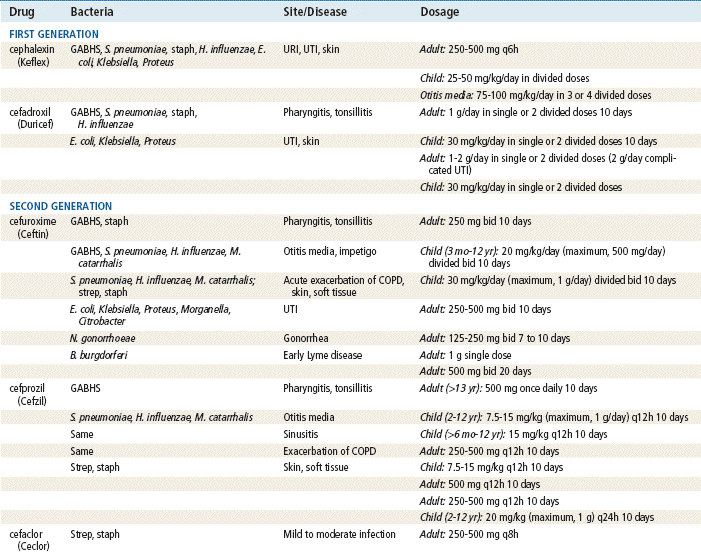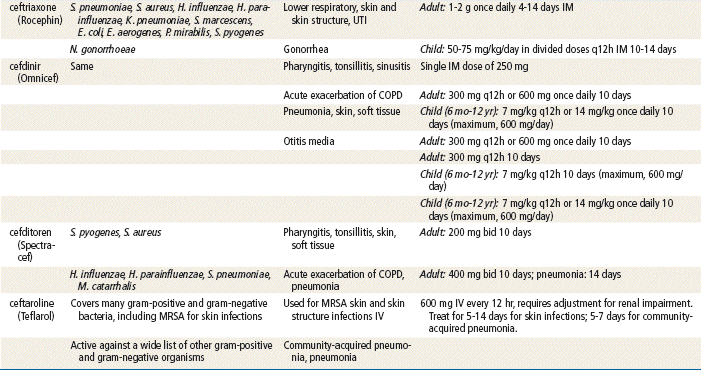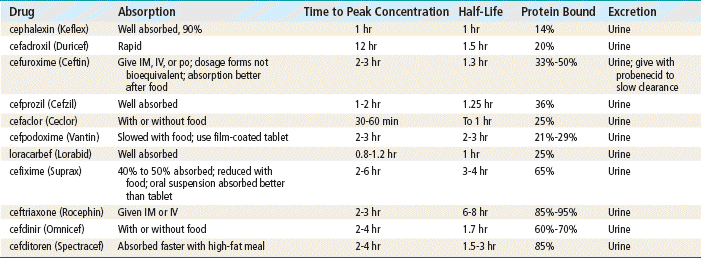http://evolve.elsevier.com/Edmunds/NP/
The mold Cephalosporin acremonium (now Acremonium chrysogenum) was discovered in sewage in Sardinia, Italy, in 1945. In 1964, the first cephalosporin, cephalothin, was marketed. Cephalosporins now comprise a large category of antimicrobials, with a wide spectrum of activity that is superior to the penicillins (Table 60-1). The generations are loosely based on antimicrobial spectrum of activity. This chapter discusses the most common oral cephalosporins, with one exception—ceftriaxone—which can be given IM in the primary care setting. Many first-, second-, third-, and fourth-generation cephalosporins are used IM or IV for serious infections and are not discussed. The primary care provider should be familiar with one oral cephalosporin from each generation. The most widely used cephalosporins for the primary care provider consist of cephalexin (Keflex), cefprozil (Cefzil), cefuroxime (Ceftin), and ceftriaxone (Rocephin).
The cephalosporins represent the most commonly used antibiotic class because of their broad spectrum, ease of administration, safety and efficacy, and favorable pharmacokinetic profile, with minimal side effects. All cephalosporins are active against most gram-positive cocci, such as Staphylococcus aureus, and many strains of gram-negative bacilli, such as Escherichia coli. Cephalosporins are classified by “generation,” with each successive generation boasting broader activity against gram-negative organisms, although at the expense of action against gram-positive organisms. Unfortunately, some organisms are developing resistance to these products. A new semisynthetic, broad-spectrum antibiotic—ceftaroline—has proven effective against some organisms resistant or insensitive to vancomycin.
Therapeutic Overview
It is widely believed that many individuals with a true penicillin allergy may also be allergic to cephalosporins. However, less than 5% of patients with a positive skin test for penicillin will react to a cephalosporin. Evidence-based guidelines of the American Academy of Pediatrics endorse the use of cephalosporin antibiotics for pediatric patients with reported allergy to penicillin for sinusitis and otitis media.
Resistance
The disadvantage of cephalosporins is that the broad-spectrum capacity of these drugs encourages rapid overgrowth of resistant bacteria, limiting their usefulness. Three general mechanisms of resistance have been identified for cephalosporins—the same ones as for penicillin. Again, the most common mechanism of resistance to cephalosporins is destruction by hydrolysis of the β-lactam ring by β-lactamase. Also important is the ability of the drug to penetrate the walls of the bacteria. If the drug can penetrate quickly, less of the drug is broken down by β-lactamase.
Cephalosporin-resistant gonocococci has increased significantly in the past 10 years. The advent of some semisynthetic products may help these drugs with resistant bacteria.
Mechanism of Action
The basic structure of the cephem nucleus includes a β-lactam ring fused to a six-member sulfur-containing dihydrothiazine ring. This is different from penicillins, which have a five-member thiazolidine ring.
Cephalosporins are β-lactam antibiotics that have the ability to resist bacterial enzymes, specifically β-lactamase. They have a similar mechanism of action to that of penicillin and interfere with cell wall synthesis through inhibition of the synthesis of the bacterial peptidoglycan in the cell wall. The antibiotic binds to the enzymes that build/maintain the cell wall. This makes the cell wall osmotically unstable. Cephalosporins are bactericidal and usually are effective against rapidly growing organisms. Cephalosporins differ in terms of which enzymes they affect.
Treatment Principles
Cephalosporins have a very wide spectrum of activity. They generally are useful for empirical treatment of many of the most common infections seen in primary care.
First-generation agents are the most active against gram-positive cocci, including β-lactamase–producing S. aureus, group A β-hemolytic streptococci (GABHS), and Pneumococcus. However, penicillin remains the drug of choice for treating GABHS pharyngitis. Cephalosporins have moderate activity against gram-negative bacilli, including E. coli, Klebsiella, and Proteus mirabilis. They are inactive against Bacteroides fragilis, Citrobacter, Enterobacter, Pseudomonas, Serratia, and all other Proteus spp. First-generation cephalosporins are not effective against Neisseria, Haemophilus influenzae, and Moraxella catarrhalis. Two first-generation cephalosporins available as oral products are commonly used. Cephalexin (Keflex) must be given every 6 hours, whereas cefadroxil (Duricef) may be dosed twice daily.
Second-generation cephalosporins continue to exhibit efficacy against gram-positive organisms, with the added advantage of increased gram-negative activity and β-lactamase stability. These drugs generally are active against some strains of Acinetobacter, Citrobacter, Enterobacter, Klebsiella, Neisseria, Proteus, Providencia, and Serratia spp. In addition, second-generation products have good activity against E. coli. They are effective against most strains of M. catarrhalis and H. influenzae, including those strains that produce β-lactamase. Many second-generation cephalosporins have been developed. The manufacturers suggest that second-generation cephalosporins may be appropriate for twice-daily dosing; however, an examination of their half-life suggests that this may not be appropriate (Table 60-2).
Stay updated, free articles. Join our Telegram channel

Full access? Get Clinical Tree



 Key drug.
Key drug.



